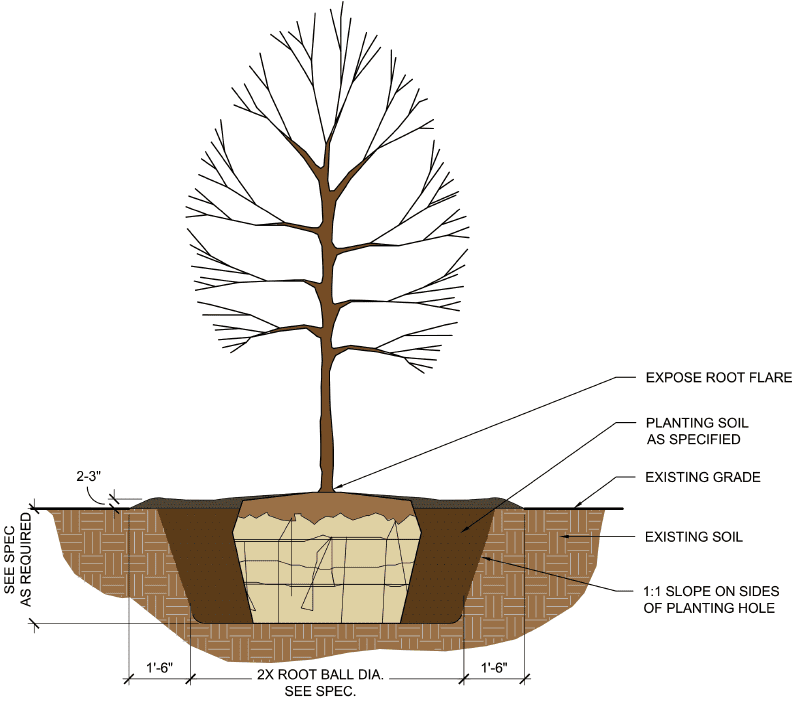From a landscape perspective, trees are the most important component of the greenway system.
Providing shade, wayfinding, a strong visual impact and a multitude of ecosystem services, trees should be extensively planted in each new greenway implementation.
- Canopy, evergreen and ornamental trees each serve different purposes and designers should consider each appropriately.
APPLICATION: Trees should be installed throughout the greenway corridor. They can be planted free-standing in turf areas or within planting areas, as specimens or in groups to create consistency throughout the project site and connecting to an adjacent trail system.
- Container grown trees are preferred to alternatively grown material.
- Deciduous trees:
- Plant deciduous trees smaller than 3” caliper, but not less than 1”.
- Trees should have a minimum 5’-0” clear trunk at time of installation if adjacent to trail (within 10’-0” of trail or within 20’-0” sight triangle at trail and road intersections).
- Do not plant evergreen trees greater than 8’-0”. Maintain clear zones at intersections of trail with walks and roads.
- Trees shall meet ANSI standards (Z60.1) for acceptable material for each species specified.
- Trees should be planted in Spring or Fall only.
CONSIDERATIONS FOR TREE PLACEMENT:
- Trees should fit within the context of the greenway corridor- see ecosystem mapping.
- Select and place appropriate trees to avoid long-term conflicts between canopy and surrounding buildings, infrastructure and existing canopy.
- Consider trail hazards:
- Limit use of trees with significant fruiting, large fruit near trails.
- Trees with a tendency to drop limbs or be otherwise “messy” should be kept away from Clear trunk requirements and sight lines.
- Maintenance considerations:
- Grouping trees into single mulch beds
- Space for mowing equipment
- Targets for canopy cover and diversity – see PLANTING VISION AND GOALS
- Soil volume requirements – see SOIL VOLUME FOR TREE HEALTH
- Soil types.
 PLANTING NOTES:
PLANTING NOTES:
- Do not heavily prune the tree at planting. Pruning should only be done to correct damage at the time of planting. Use corrective pruning techniques after establishment based on ISA standards.
- If plant is shipped with a wire basket around the root ball, remove all twine, rope, burlap, and wire basket from top 1/3 of root ball.
- Mark the north side of the tree in the nursery, and rotate tree to face north at the site when ever possible.
- Set top of root ball flush to grade or 1-2 inches higher in slowly draining soils.
- If planting pits are excavated using a power auger, break vertical sides with a balling bar or spade to interrupt continuous curve influence on root development.
- If planting pits are hand dug, scarify sides of pit.
- 2” to 3” inches of mulch. Do not place mulch in contact with tree trunk. Mulch ring to cover earth saucer.
- Stake trees only as needed according to ISA guidelines.
- Place root ball on unexcavated or tamped soil.
- Tamp soil around root ball base firmly with foot pressure so that root ball does not shift.
- Each tree must be planted such that the trunk flare is visible at the top of the root ball. Trees where the trunk flare is not visible shall be rejected. Do not cover the top of the root ball with soil.
- See STAKING.

